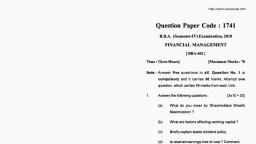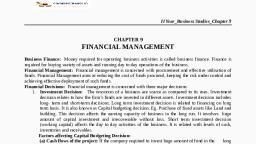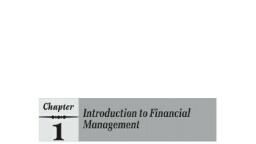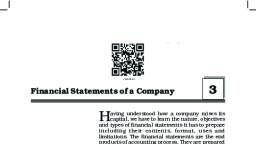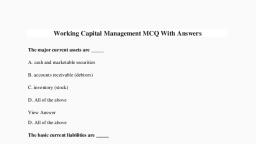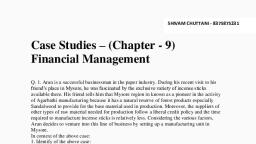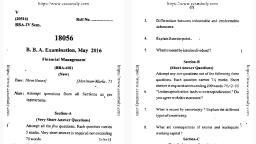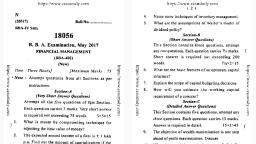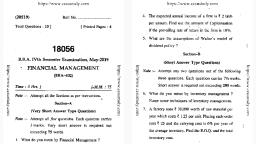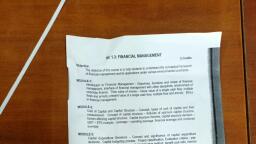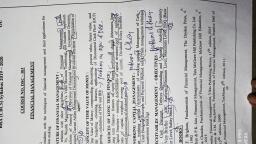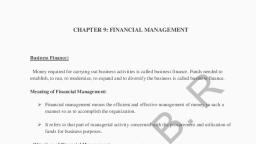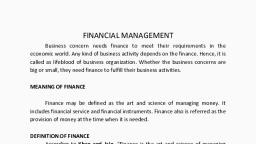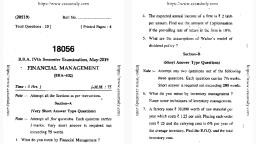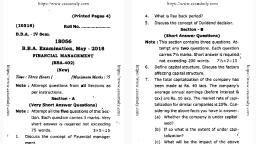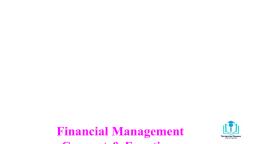Page 1 :
FINANCIAL MANAGEMENT 3RD SEM B.COM, , FINANCIAL MANAGEMENT, III SEMESTER B.COM, , PREPARED BY:, ELANGOVAN V, , CHARAN’S DEGREE COLLEGE, ULSOOR , BANGALORE, , Page 1
Page 2 :
FINANCIAL MANAGEMENT 3RD SEM B.COM, , TABLE OF CONTENTS, , Sl., , Unit / Chapter, , No, , Page Nos., , 1., , Introduction to financial management, , 2 – 31, , 2., , Time Value of Money, , 16 – 38, , 3., , Financing & Dividend Decisions, , 18–47, , 4., , Investment Decisions, , 29– 53, , 5., , Working Capital Management, , 34 – 66, , CHARAN’S DEGREE COLLEGE, ULSOOR , BANGALORE, , Page 2
Page 3 :
FINANCIAL MANAGEMENT 3RD SEM B.COM, Chapter 1 – Introduction to financial management, , INTRODUCTION, In our present day economy, Finance is defined as the provision of money at the time when it is, required. Every enterprise, whether big, medium or small needs finance to carry on its operations, and to achieve its targets. In fact, finance is so indispensable today that it is rightly said to be the, life blood of an enterprise., , MEANING OF FINANCE, Finance may be defined as the art and science of managing money. It includes financial service, and financial instruments. Finance also is referred as the provision of money at the time when it, is needed. Finance function is the procurement of funds and their effective utilization in business, concerns. The concept of finance includes capital, funds, money, and amount. But each word is, having unique meaning. Studying and understanding the concept of finance has become an, important part of the business concern., , Finance is mainly concerned with, 1) The provision of money at the time it is required, 2) Management of flow of money through an organization, 3) Application of skills in the manipulation use and control of money., Without finance, no activity can be carried out finance is known as the life blood of a business, and the success of a business depends on the flow of finance., At may also be defined as the administrative area as set of administrative functions in an, organization, which relates with the arrangement of cash and credit find so that the organization, may have the means to carry out its objective as satisfactorily as possible., , CHARAN’S DEGREE COLLEGE, ULSOOR , BANGALORE, , Page 3
Page 4 :
FINANCIAL MANAGEMENT 3RD SEM B.COM, Finance as the life blood of a business:, 1. Life :- without finance, there is no life for an undertaking just like blood gives life to an, individual, finance gives life to an organization. This is the same case for both trading, and non trading concerns charitable concerns., 2. Flow:- If there is finance, but no flow of finance through the organization by way of, different elements, then the organization is dead just like in the case of human’s, when, there must be a circulation of blood., 3. Donation:- Finance should be capable of being donated from one organization which of, has a suspires to another organization which feels a difficult. The blood of humans is also, capable of being donated., 4. Quality :- The health of a person depends in the quality or pureness of blood flowing, through him, IIIly, the health of a organization depends on the quality of finance which in, turn depends on., 1) The cost of finance: - The cost of capital must be minimum., 2) The source of finance: - The cost of source finance adopted must be feasible to the, organization., 3) Quantity: - If there is surprises deficient blood in the human body. It May give rise to, many deficiencies and diseases. IIIly in an organization if the co is under capitalized or, over capitalized; the c.o is likely to face many problems., , DEFINITION OF FINANCE, •, , According to Wheeler, business finance may be defined as “that business activity which, is concerned with the acquisition and conservation of capital funds in meeting the, financial needs and overall objectives of the business enterprise.”, , •, , According to Guttmann and Dougall, business finance may be broadly defined as “the, activity concerned with the planning, raising, controlling and administering the funds, used in the business.”, , BUSINESS FINANCE, It refers to the funds and monetary support required by an entrepreneur for carrying out various, activities relating to his/her business organisation., , Financial Management: - Is that part of management activity which is concerned with the, planning and controlling of firms financial resources. It involves financial planning acquisition, of funds, use and allocation of funds and financial controls., CHARAN’S DEGREE COLLEGE, ULSOOR , BANGALORE, , Page 4
Page 5 :
FINANCIAL MANAGEMENT 3RD SEM B.COM, Financial Engineering: - Refers to the design, development and implementation of new,, innovation financial instruments and their formulation of creative optimal solutions to problems, in finance., Users/Importance of Financial Management, 1. Financial Planning and successful promotion of an enterprise: - The changes of future, growth and expansion are all considered and thereby the requirement of finance is made., 2. Requisition of funds at the min possible cost: - The various sources of funds are, appraised and evaluated and the best one which is the most economical to the, organization is selected., 3. Proper allocation of funds: - There is an optimum allocation of the funds raised it the, funds raised are, allocated or distributed in such a manner that they give the max returns, to the organization., 4. Taking sound financial decisions: - In the complete worked of today, good, proper,, stable and sound financial decision are very necessary and financial management helps in, this., 5. Improving Profitability through financial controls: - Proper and efficient financial, controls are established through financial management in order to ensure that the, company reaps profits in the future., 6. Increasing the wealth of the investors: - Proper financial management ensures that the, investors of the concern get a reasonable return on their investments and this in turn, increases the wealth of the nation., , CHARAN’S DEGREE COLLEGE, ULSOOR , BANGALORE, , Page 5
Page 6 :
FINANCIAL MANAGEMENT 3RD SEM B.COM, Finance Function: Refers to the raising of capital funds and bringing them for generating return, and paying returns to the supplier of the fund. [Guttmann & this is the most important of all sun, gal] functions since the starts with the setting up of an enterprise and remains there at all times, the inflows & outflows must properly matched, , Finance function, The classification of finance function can be studied in 2 different way’s, 1) As traditional & modern finance functions., 2) As managerial & routine finance functions., 1) Traditional approach: - Under this, the scope of the finance function was confined only to, the procurement of funds needed by the business and utilization of funds was considered beyond, the preview of the function. But financial institutions form a part of the functions., , Limitations, 1) Utilization of funds was not considered., 2) Only long term sources were considered, working cap not considered., 3) Day to day financial problems is not analyzed., 2) Modern approach: It included both the raising as well as proper utilization of funds. The cost, of raising funds and their returns are also compared here and modern financial engineering, techniques are used for this financial problems are considered., Managerial functions: These are functions which involve executive, professional skills and is, mainly concerned with vital decision making. This can be done only by the top level, management. This is further divided into., 1) Investment function (Asset mix) this consists of mainly project appraisal and selections., Project evaluation is made here through IRN, NPX, payback etc once the best project is selected,, and turns the cap fund requirements workings, (the relation b/w fix & current assets)capital requirements. The asset requirements etc are, decided here. The credit policy is also decided here, 2) Financing function (cap mix): In this stage, the total fund requirements are decided, the, various sources of raising funds are evaluated and the best method is selected this firms the basis, , CHARAN’S DEGREE COLLEGE, ULSOOR , BANGALORE, , Page 6
Page 7 :
FINANCIAL MANAGEMENT 3RD SEM B.COM, for determining the end structure of the firm. (relationship b/w the develop equity in the total, capitalization)., Here the cost of capital of each element of capital is considered and the weighted and cost of, capital is found out. This is in turn concepts with the return in investment and then the capital, structure is determined. The row should be equal to or more than the avg. weighted cost of the, capital., 2. Appropriation [payout ratio] Under this, the payout ratio is determined i.e. pay out ratio, Dividend per share: - This ratio determines, , earning per share., , What should be the dividend paid and what should be the retained earning etc. The effect of such, decisions on the cost of capital and the market price is also analyzed., If we pay more dividend, the market price of shares will be increased. III ly, expansion, programmes may induce the co to keep more amount as retained earnings, provided the cost of, outside borrowing is more and this reduces the cost of capital., Routine functions: - These functions do not require any special skill since they do not involve, much of vital decision making these are usually performed by the clerical staff. This includes., 1) Managing cash: - The inflow, outflow etc cash should be managed and the surplus deficit etc, should be determined. For this cash budgets are prepared. The surplus cash is usually invested in, marketable securities. The deficits are meet from cheaper sources of funds., They usually prepare, a. Cash book (shows actual receipts & payments), b. Cash budget (expected receipts & payments), 2) Safe custody of valuables & securities: The accountant has to keep safe the valuables &, securities and he is responsible or accountable for it., 3) Record keeping: The office manager has to maintain proper records giving the entire details of, all the transactions., 4) Reporting: The clerical staff will have to give the timely reports to the top level management., , CHARAN’S DEGREE COLLEGE, ULSOOR , BANGALORE, , Page 7
Page 8 :
FINANCIAL MANAGEMENT 3RD SEM B.COM, 5) The details from the various sources from which the finance is raised must also be specially, mentioned., Financial management: also refers to the acquisition of funds and its effective utilization ., , Scope/Functions of finance manager/Mgmt/Elements of financial management, 1. Estimating the financial requirements: - This is done after the selection of the project, through various evaluation techniques such as NPX,INX etc. The requirements vary from, project to project. Once the project is selected, both long terms and short term financial, requirements are determined long term financial requirements determine what amount of, money should be invested in fixed assets such as land, building etc. The short term, financial requirement deal with the min bal of cash, stock etc that should be maintained., The short term liabilities are deducted from this to get the working capital requirements,, which in turn are added to the long term requirement funds., Short term liabilities include supplier’s credit institutional credit etc., 2) Determining the capital structure: - Once the financial requirements are decided, the various, sources of raising finance are analyzed and the capital structure is decided. This is decided on the, basis of ex. The relationship b/w debt & equity is decided., 1) Comparing the cost of capital of each element of fund and the Rol. The Rol, should always be more than the Rol., 2) The availability of the source of fund: - The fund must be quickly and readily, available without any difficult and lengthy formalities., 3) The purpose of the fund: - The purpose of the fund also determines the source, of fund ie. If fixed assets need to be financed, then irredeemable sources are preferred, [which need not be paid during the life time of the company]., 3) Selecting the sources of finance: - After preparing a capital structure an appropriate source of, finance is selected. Various sources of finance may be raised such as share cap, debentures,, public deposits etc. If finances are needed for short periods, then banks and public, deposits may be appropriate on the other hand if long term finances required then sh cap &, debentures are preferred. The effect of each item on the control of the co, the market price of, The shares etc are considered -> this is for ownership securities eg.more eq. shares my change, the present control ratio. The debt fund can be raised by comparing the cost of each item of, Debt capital to its risk business. Negotiations are conducted with various parties and thereby the, terms & conditions are fixed., , CHARAN’S DEGREE COLLEGE, ULSOOR , BANGALORE, , Page 8
Page 9 :
FINANCIAL MANAGEMENT 3RD SEM B.COM, 4) Selecting a pattern of investment: -Here what all fixed and current assets and the wc are, decided. Also the various elements of fixed and current assets are decided., Risk return, profitability is taken into consideration while selecting the pattern of invest me at this forms a, part of project implementation. The funds will have to spent just on fixed assets and then an, appropriate portion will be retained for working capital., 5) Proper cash management: - Cash may be required to (1) purchase raw materials make (2), payments to creditors (3) meet wage bills (4) meet day to day expenses. The usual sources of, cash may be (1) cash sales(2) collection of debits (3) short term arrangements with banks etc., There must be a proper management b/w the inflow and outflow of cash for this cash budgets,, cash flow statements etc are prepared. Cash flow statements shows the inflow & outflow of cash, and the reasons for a difference in th op. and etc. Bal of cash.Cash management is needed for, keeping safe liquidity positions, Minimize cost also to prevent the misappropriation of cash,, fund etc., this is done through preparation of cash budgets, cash books, comparing the balances, of cash book with the actual physical cash., 6) Working capital management: - Working capital is one of the factors that is essential for the, smooth functioning of a business. Here the various levels of individual current assets must be, fixed taking into consideration the lead time of the assets ie. Time required for the replenishment, of current assets. The availability of the short term and long term of sources of financing is, decided here., 7) Financial Control: - Proper control must be established in finance to ensure that the exp do, not exceed the revenue and the following tools helps in this, 1. Budgetary control, 2. Break even analysis, 3. Ratio analysis, 4. Standard costing, 5. Other financial tools, 6. Ratio analysis, These tools ensure better financial performance and keeps in taking corrective, measures also, 8) Proper use of surplus: - This can take place only through proper profit planning and, controlling or through proper appropriate decisions. These decisions depend on: 1) Need for internal financing: - Ploughing back of profits will be done only if there, are expansion programmes and the cost of external borrowing is high., 2) Trend of earnings: - If the earnings show an increasing trend the chances of profits, are likely to be high and there is no need to keep Aside any amt in the form of, dividend equalization fund etc., CHARAN’S DEGREE COLLEGE, ULSOOR , BANGALORE, , Page 9
Page 10 :
FINANCIAL MANAGEMENT 3RD SEM B.COM, 3) Effect of layout ratio on the value of the firm sometimes the market, Price of shares depend to a large extent on the payout ratio. ie., on the DPS. In this, case more dividend is paid than keeping aside a retained profits., 9) Dividend policy: - The policy regarding declaration of dividend should also be take by the, finance manager. There are many method of declaring dividend such as: a. Regular dividend: - If such a policy is followed, then in all yes. A, Dividend is declared., b. Uniform dividend: - Under this policy, the same rate of dividend, is, Declared for all the years irrespective of the earnings., c. Irregular dividend: - Here dividend is declared on the basis of the, Earnings earned and hence its irregular and also the rate of dividend may vary from, year to year., , Objectives/Concepts of Financial Management, The three main objectives of financial management, 1. To maximize the profitability of the firm., 2. To maximize wealth of shareholders., 3. To maintain liquidity of the firm., These objectives are based on 2 different concepts namely., 1. Profit maximization, 2. Wealth maximization, Some experts favour the Ist concept and some the second but the basic, Objective is to maximize economic welfare of the owners. According to the 1 st group of experts,, economic welfare can be increased only by increasing the profitability whereas the others believe, it can be increased only by increasing the wealth., Concept of profit maximization., Profit is maximized by increasing the sales turnover and minimizing the cost of manufacturing,, administration and financing. According to this concept business is an economic activity and the, basic objective is the generation or creation of profit and so the objective of the business must be, profit maximization and since financial management forms a part of business its objective must, also be profit generation or maximization., CHARAN’S DEGREE COLLEGE, ULSOOR , BANGALORE, , Page 10
Page 11 :
FINANCIAL MANAGEMENT 3RD SEM B.COM, The efficiency of the management of the business depends on the profitability or return ie.,, profitability is the basic measure to check the efficiency of the management means increased, profit generation, , Basic arguments in favour of profit maximization, 1. Aim of business: The basic aim of a business is to earn profit and not the maximization of, wealth and hence the aim of fm should also be profit maximization. This can be done in, many ways:a. reducing the cost of finance by carrying out the finance by means of ploughing back of, profits but this reduces the wealth of the share holders since if its declared as dividend, they, can invest it in outside securities and there earn a higher return on investment., b. The additional fund or cap required may be saved using additional eq cap since they are, cheaper compared to pref. shares or debentures. This also reduces the cost of financing., 2. Rationality:- Says that management ie. Efficient only if the profit are maximized and not if, wealth is maximized. Taking decisions based on specific reasons. A rational investor will, invest in the business only if it has the maximum profitability. Wealth is an internal of matter, and its not fully disclosed and so profit forms a major criteria to the investors for taking, investment decisions so rationality calls for profit mass., 3. Survival: - A prudent management always focuses on profit maximization when situations, are for this may be done by ploughing back the profits. This profit will be made use of during, bad times or periods of depression. Then , the business firms can survive. Hence for the, business to survive, profit maximization is very important., 4. Growth& development: - For the growth and development of a concern, retained earnings is, essential and retained earnings can be generated or increased only by profit maximization., 5. Social objectives of the business: - For social, economic welfare, profit maximization is, required because of a reasons social economic welfare is takes place in the form of, 1) Increased employment, 2) Increased remuneration, 3) Increased standard of living, Wealth maximization is not reflected at all in the economy., Criticisms against profit maximization, 1. Lack of clarity: - According to the concept of profit maximization, max of economic welfare, can take place only through profit maximization but there are no specific directions as to this, , CHARAN’S DEGREE COLLEGE, ULSOOR , BANGALORE, , Page 11
Page 12 :
FINANCIAL MANAGEMENT 3RD SEM B.COM, correct meaning of profit. Does it mean short term profits or long term profits does it mean, total profits or earnings per share. Should we take profits before or after tax etc?, 2. Ignores time value of money: - This concept ignores the time value of money is the concept, is purely based on the comparison b/w cash inflows and outflow and the net inflows are tried, to be maximized without any references to the change in money value. It does not consider, the magnitude and timing of earnings. It treats all earnings as equal even though they occur, in different periods. “A rupee earned today is better than a rupee earned tomorrow is ignored, here”., 3. Conflicting interest of parties: - The owners of the business are interested in maximizing their, wealth while the management is interested in maximizing the profit while the creditors are, concerned with their safety only. Therefore when the profit maximization is taken as the sale, objective, the interests of various parties are conflicted. Hence this concept is considered, inadequate., 4. Ignores risk factors: - Risk and profit are positively related. More risk may result in more, return and hence to get more return, the finance manager may take huge risks and this may, affect the future or survival of the concern. The risks of the prospective earnings stream are, ignored., 5. Exploitation: - The concept of profit maximization supports exploitation supports since profit, is possible only if some classes of the society such as customers (in the form of cheap goods),, employers (low wages), govt (non payment of taxes) are exploited., 6. Corrupt practices: - The concept of profit maximization may care for illegal activities or, corrupt practices. Also profit maximization cannot be the legitimate objective of firms in, present situations and thereby profit maximization would mean embracing illegitimate, practices., 7. Ignoring human values: - This involves increasing profit by the nonpayment of due payments, to the various factors of production. It leads to closed inequalities and lowers human values, which are an essential part of an ideal social system., 8. Profit maximization is possible only in a situation where perfect competition prevails., Concept of wealth maximization, As per this concept, the economic welfare of the owners can be maximized only by maximizing, the wealth of the owners. The wealth can be both current wealth and long term wealth. Wealth, maximization is the single substitute for a stock holders utility., , CHARAN’S DEGREE COLLEGE, ULSOOR , BANGALORE, , Page 12
Page 13 :
FINANCIAL MANAGEMENT 3RD SEM B.COM, 1. Current wealth = NXPO, (Wo), Where: N = No. of shares, Po = Market price of shares, Given the no. of shares that the stock holder owns, the higher the stock price per share, the, greater will be the stock holders wealth thus a firm should aim at maximizing the stock price, which will in turn increase the wealth of the stock holders and the reputation of the firm., 2. Long run wealth, = NPV = TPV - C, Where:, NPv = Net present value, TPv = Total present value, C = Initial investment, Under this, the time value of money is considered. The net present value of the various projects,, are considered and the project with the max NPv is selected. So that the share holders wealth is, maximized. To get the NPv of the projects, deduct the initial investment of the project from the, total present value, Wealth maximization aims at selecting the best project whereas profit, Maximization aims at maximizing cash inflows. Also discounting of cash inflows takes place, here unlike in profit maximization., Arguments in favor of wealth maximization, 1. Considers the time value of money: - The long run wealth is obtained by, Adding up the, NPv of different projects under consideration due consideration is given to the changes in, money value ie. Future cash inflows are discounted to get the NPv. [NPv means the rate at, which the wealth of the investors increase ie. It refers to the increase in the initial, investment]. This is based on the concept of cash inflows generated by the decision rather, than accounting profit. This avoids ambiguity., , CHARAN’S DEGREE COLLEGE, ULSOOR , BANGALORE, , Page 13
Page 14 :
FINANCIAL MANAGEMENT 3RD SEM B.COM, 2. Considers both quality and quantity dimensions of benefits: The quality of benefits has a, reference to the certainty with which benefits are expected to be received in future. The more, certain the cash inflow, the better the quality of benefits and higher the value., 3. Consider risk factors: Unlike profit maximization where only return is considered and not the, element of risk. He take into consideration the risk factor also. This is because the basis of, taking decisions here is the NPv., 4. Optimization of source resources: The scare resources are effectively allocated because here, we take into consideration the appreciation is wealth and this is possible only if an optimum, utilization of productive resources is made. The resources may be financial resources,, material resources etc., 5. Beneficial to owners: The wealth is reflected either in the form of Po or NPV and this is very, essential for determining the economic welfare of the owners. Profit maximization may, favour the investors only if there is a 100% payout ratio. Po is important because it will, determine how much the owner will get on selling his investments and NPV is important, because it’s the factor which determines the rate of appreciation, Arguments against favor of wealth maximization, 1. Difficult to calculate because, a. The project may not continue., b. Future inflows may be different., c. The discount rate is not correct., 2. Not socially desirable: - The concept is not socially desirable because the objective of a, business under this is to max wealth and the social responsibilities of the business is, completely ignored. Some benefits are not emphasized here., 3. Controversy as to wealth maximization: - There is a conflict regarding the concept of, wealth is whether the wealth of the owners or investors has to be maximized. The, ownership fund sometimes may be high. In this case, even if the wealth of the owners are, maximized, the risk of the creditors may not be reduced., 4. Conflicting interests: - The owners are interested in maximizing their wealth the, management is interested in profit maximization and the creditors are interested in their, safety. Hence there is a conflict b/w the interests of various parties., , CHARAN’S DEGREE COLLEGE, ULSOOR , BANGALORE, , Page 14
Page 15 :
FINANCIAL MANAGEMENT 3RD SEM B.COM, 5. Projects of social needs are ignored: - Projects of social needs are ignored since NPV is, the sale criteria for selection. Projects which are required socially may have a low NPV, and hence these projects may not be preferred and projects with high NPv may not be, very beneficial to the society, E.g. Hospitals, Liquor, , Low NPV but socially desirable., High NPV but socially not very desirable., , Meaning of Financial Plan, •, , A plan that estimates the amount of funds required and decides the proportion of debtequity., , Objectives of Financial Plan, •, •, •, •, •, •, •, , Ensure availability of sufficient funds, Balances risk and costs, Simplicity, Flexibility, Liquidity, Optimum use, Economy, , Need and Importance of Financial Planning, , Principles and Characteristics of Sound Financial Plan, •, •, •, •, •, •, •, •, •, , Simplicity, Foresight, Flexibility, Liquidity, Economy, Provision for Contingencies, Optimum use, Objectivity, Stake holder’s perspective, , CHARAN’S DEGREE COLLEGE, ULSOOR , BANGALORE, , Page 15
Page 16 :
FINANCIAL MANAGEMENT 3RD SEM B.COM, Process of financial planning/Steps in financial planning, •, •, •, •, •, , Assessing business environment, Developing Financial goals, Planning Financial policies & Procedure, Ensuring adaptability & flexibility, Review of Financial plan, , Classification of Financial plan, Long-term Financial Plan, •, , Long-term Financial Plans: Layout a firm’s financial action, and anticipated impact of, those actions over a long-term plan, , Short-term Financial Plan, •, , Short-term Financial Plans: Specify short-term (1 to 2 years) financial actions and the, anticipated impact on those action, , •, Factors Affecting Financial Plan, •, •, •, •, •, •, •, •, •, •, •, •, , Nature of Industry /business, Company Status, Alternative Sources of Finance, Management’s attitude towards Control, Magnitude of external capital requirements, Future plans, Flexibility, Government policy, Risk appetite, Economic conditions, Study of financial markets, Government policies and control, , Limitations of Financial Plan, •, Difficulty in accurate forecasting, •, Absence of Co-ordination, CHARAN’S DEGREE COLLEGE, ULSOOR , BANGALORE, , Page 16
Page 17 :
FINANCIAL MANAGEMENT 3RD SEM B.COM, •, •, •, , Difficult to change, Changing business environment /Rapid Technological changes and customer preferences, Use of information, , CHARAN’S DEGREE COLLEGE, ULSOOR , BANGALORE, , Page 17
Page 18 :
FINANCIAL MANAGEMENT 3RD SEM B.COM, Chapter 2– Time value of money, Time value of money, A rupee that is receivable today is more valuable than a rupee receivable in future. Put in simple, words, to days money is more valuable was future money., Rational of Time Preference for Money, • Uncertainty, • Current consumption, • Possibility of investment opportunity, Simple Interest, The interest paid on original amount or principle amount, SI = Po(I)(n)., where SI = Simple Interest, Po = Principle amount at year ‘0’, I = Interest rate per annum, n = Number of years for which interest is calculated., Compound Interest, The interest that is earned on a given deposit and has become part of principal at the end of, a specified period, CV = Po (1 + I)n, where CV = Compound value, Po = Principal amount, I= Interest per annum, n= Number of years for which compound is done., (1 + I)n= CVIFI..n or future value inter factor for, interest and ‘n’ years., Variable Compounding Periods, mn, , I , , CVn = Po 1 + , M, where CVn = Compound value at the end of year ‘n’, Po= Principle amount at the year ‘0’, I= Interest rate per annum, m= Number of times per year compounding is done, CHARAN’S DEGREE COLLEGE, ULSOOR , BANGALORE, , Page 18
Page 19 :
FINANCIAL MANAGEMENT 3RD SEM B.COM, n = Maturity period, Compounded Value of Series of CFs, CVn = P1 (1+I)n-1 + P2 (1+I)n-2 + ………… Pn-1(1+I)+Pn, where CVn = Compound value at the end of ‘n’ year, P1 = Payment at the end of year 1, P2 = Payment at the end of year 2, Pn = Payment at the end of year ‘n’, I = Interest rate, CVn = P1 (CVIFI.1)+ P2 (CVIFI.2) + …………Pn(1+II.n), Doubling Period, Rule of 72 = 72/I, Rule of 69 = 0.35+(69/I), I=Interest rate [ for example 10%, 20%, 30%, etc.], Present Value Concept, Pv Is the future cash inflow (outflow) is the amount of current cash that is of equivalent value of, the present value, Present value of single amount, PV = FVn PV = FVn, or FVn [PVIFI.n], where PV = Present value, FVn = Future value receivable at the end of ‘n’ years, I = Interest rate or discounting factor or cost of capital, n = Duration of the cash flow., PVIFI.n = Present value interest facts at ‘I’ interest and for ‘n’ years, , Valuation of bonds, •, , Book Value:It is equal to cost of an asset minus accumulated depreciation, , •, , Market Value:It is the value at which the asset is bought or sold in the market., , •, , Liquidation Value:The actual amount can be realized when an asset is sold at the end of, closing business., , CHARAN’S DEGREE COLLEGE, ULSOOR , BANGALORE, , Page 19
Page 20 :
FINANCIAL MANAGEMENT 3RD SEM B.COM, •, , Going Concern Value:Value realized when a running business is sold., , •, , Intrinsic Value:Present value of cash inflows expected from a asset over its holding, period., , Basic valuation model, , n, , , , CIFt, CIFn, V=, +, t, n, (, 1, +, K, ), (, 1, +, K, ), t =1, Alternatively,, V = (CIF × PVIF ) + (CIF × PVIF ), t, , Where V, , t, , n, , n, , = Value of the asset at time ‘zero’, , CIF = Cash inflow (return) expected at the end of year ‘t’., t, , K, , =, , Required rate of return [discount rate], , n, , =, , Maturity period, , PVIF, , = Present Value Interest Factor, , Stock valuation, •, , Equity Stock Value: It is the present value of a stream of dividends expected over, holding or infinite period as the case may be, , ESo =, , , , , t =1, , Dt, t = 1(1 + Ke ) t, , Basic Stock Valuation Model, Alternatively, CHARAN’S DEGREE COLLEGE, ULSOOR , BANGALORE, , Page 20
Page 21 :
FINANCIAL MANAGEMENT 3RD SEM B.COM, , ESo =, , D1, D2, D, +, +, ......., +, (1 + K e )1 (1 + K e ) 2, (1 + K e ) , , Where: ESo = Value of equity stock, Dt = Expected dividend per share at the end of year ‘t’., Ke = Required return on equity (cash of equity), , Chapter 3 – Financing & Dividend Decisions, Meaning of Capital Structure, Capital Structure: Include only long-term debt and total stockholder investment, Capital Structure = Long-term Debt + Preferred Stock + Net worth (or), Capital Structure = Total Assets – Current Liabilities, Optimum Capital structure, The level of debt equity proportion where market value of share is maximum, and cost of capital, is minimum, Features:, • Profitability, • Solvency, • Flexibility, • Conservatism, • Control, Determinants of Capital structure, •, •, •, •, •, •, , Financial leverage or trading on equity, Flexibility, Control, Growth and stability of sales, Cost of capital, Debt servicing ability, , CHARAN’S DEGREE COLLEGE, ULSOOR , BANGALORE, , Page 21
Page 22 :
FINANCIAL MANAGEMENT 3RD SEM B.COM, •, •, •, •, •, •, •, •, , Nature and size of firm, Requirement of investors, Cost of floatation, Asset structure, Corporate tax rate, Period of finance, Purpose of finance, Legal requirements, , Patterns of Capital Structure, • Complete equity share capital;, • Different proportions of equity and preference share capital;, • Different proportions of equity and debenture (debt) capital, • Different proportions of equity, preference and debenture (debt) capital., , Leverage, Leverage: The action of a lever and mathematical advantage gained by it. It refers to the use of a, fixed element and gaining the benefits from it. It can either be a fixed cost or a fixed charge, bearing security. Use of fixed cost will result in operating leverage and use of fixed charge, bearing securities will result in financial leverage., Types of Leverages:, Operating leverage, Financial leverage, Combined leverage, Operating Leverage = Contribution / EBIT, Degree of operating leverage = Change in EBIT/ Change in sales, Financial Leverage = EBIT / EBT, Degree of financial leverage = change in EPS / change in EBIT, Combined Leverage = Contribution / EBT, Degree of combined leverage = Change in EPS / Change in sales, CHARAN’S DEGREE COLLEGE, ULSOOR , BANGALORE, , Page 22
Page 23 :
FINANCIAL MANAGEMENT 3RD SEM B.COM, Dividend Decision, Dividend is “that part of profit distributed among share holders which includes normal rate of, interest plus a return for the risk assumed”., A firms dividend policy affects both the long term financing and the wealth of the shareholders., Forms of Dividend:, •, , Cash Dividend: Most companies pay the dividends in cash sometimes cash dividend may be, supplemented by a stock dividend A company should have enough cash in its bank account, when cash dividends are declared. The cash account and the reserves account of a company, will be reduced when cash dividend is paid., , •, , Stock Dividend: A Stock dividend represents a distribution of shares in lieu of or in addition, to the cash dividend to the existing share holders in proportion to the no of shares held by, them. This has the effect of increasing the number of outstanding shares of the company., , Advantages of stock dividend:, •, , •, , •, , •, , •, , •, , Tax Benefit to the share holders: One of the advantages to the shareholders in the receipt of, stock dividends is the beneficial treatment of such dividends with regard to income taxes, since cash dividend is liable to be taxed., Indication of higher future profits: the payment of stock dividend is normally intercepted by, shareholders as an indication of higher profitability since stocks dividends are usually, declared only when they expect a rise in earnings., Future dividends may increase of a company has been following a policy of paying a fixed, amount of dividend per share, the total dividend of the share holder is likely to increase since, the no of shares increase., Psychological Value: The declaration of stock dividend has a favourable psychological effect, on the share holders. The receipt of stock dividend gives them a chance to sell their shares to, make capital gains., Conservation of cash to the co: the declaration of stock dividend allows the company to, preserve or conserve cash that may be needed to finance the profitable investment, opportunities within the company dividend can be declared as well as the earnings can be, maintained., Only means to pay dividend under financial difficulty and contractual restrictions. In some, situations even if the company’s intention is not to retain earnings, the stock dividend is the, only way to declare dividend and satisfy the share holders., , CHARAN’S DEGREE COLLEGE, ULSOOR , BANGALORE, , Page 23
Page 24 :
FINANCIAL MANAGEMENT 3RD SEM B.COM, •, •, , More attractive share price: sometimes the co declares stock dividend to reduce the market, price of the share and to make it more attractive to the investors., Stock split is a method to increase the no of o/s shares through a proportional reduction in the, par value of the share. In stock dividend, earnings and reserves a/c decreases but par value, remains the same and vice versa., , Limitations of stock dividend:, •, •, •, •, , •, , Reduction in eps: if a co with normal or low eps declared stock dividend the eps will further, reduce and this ______ the market price of the shares., Costly extra admn. Exp. Has to be increased unlike cash dividend where there are no separate, or extra formalities., Legal Problems: there are a lot of legal problems and formalities like the permission from, court, comptroller of capital issues etc have to be obtained., Reduce MPS: due to the reduction in EPS of the company, the MPS of the shares of the, company also gradually, decreases and this is not very advantages to the co., , Scrip Dividend: means disbursement of dividend in the form of serip or promissory notes., The dividend is declared but the payment of the dividend is on a future date and such, payments are in the promissory notes on the actual payment of dividend is postponed here, the control of cash outflow is done here., Thus this method is a method which postpones the actual payment to a date mentioned on the, promissory note., , OCCASSIONS IN WHICH SCRIP DIVIDEND IS DECLARED:, •, •, •, , There are sufficient earnings but cash position is weak – in such cases, the dividends can be, declared but payment can be made only on a future date., When the company follows a regular dividend policy without immediate realisation or, payment of the dividend in cash., When the company is unable to go for stock dividend since it has a low or normal eps for the, payment of dividend., , Bond Dividend: Here the company issues its own bonds to the share holders carrying a specified, rate of interest equal to the dividend due to them. This is almost similar to the serip dividend, except that here the postponement of the dividend is for a long period of time and hence for this, long period, they offer interest the maturity of the scrip is lower than the maturity of the bond., This is also declared when the co has sufficient earnings but a weak liquidity position., CHARAN’S DEGREE COLLEGE, ULSOOR , BANGALORE, , Page 24
Page 25 :
FINANCIAL MANAGEMENT 3RD SEM B.COM, , Property Dividend:Here the co pays the dividend in the form of assets or properties and not in, the form of cash or credit instruments. The assets or properties include:-, , •, •, •, , Goods manufactured, Goods in excess, Goods which are low useless to the co., , Dividend Policy:, Refers to the guidelines for the declaration and management of dividend and retained earnings of, the company., “it refers to the attitude of the management concerning how much of the profit should be, distributed as dividend, and when and how it shall be distributed”. The mgmt should decide all, these within the framework specified., DETERMINANTS OF DIVIDEND POLICY:, , •, , Payout ratio: determines the percentage of profits to be distributed as dividend and what %, to be kept as retained earnings. Payout ratio can be kept at high normal or low basis. In high, payout ratio, major portion is declared as dividend and only a less amount is kept as reserves, and vice versa if a low payout ratio is maintained. if our payout ratio is normal earnings are, equally distributed as dividend and reserve of the shareholders prefer instant earnings, then a, high payout is fixed and if the share holders prefer a maximization wealth, a lower payout, ratio is fixed., , •, , Stability of dividend:- Dividend policy of a company may be:, • Constant fixed DPS in this policy the same amount of declared for all the years and, changes in earnings do not affect the amount of dividends., • Constant dividend payout ratio: here the portion of earnings declared as dividend will be, the same. Dividend per share varies in direct proportion with the EPS., • Constant dividend per share and extra dividend: the company declares constant dividend, per year every year plus extra dividend for earnings beyond a certain prefixed limit., • No Immediate Dividend: here the actual payment of dividend of any year can be, postponed to a future date by the issue of scrip or bond dividend., • Regular stock dividend: Here stock dividend is declared instead of cash dividend., , CHARAN’S DEGREE COLLEGE, ULSOOR , BANGALORE, , Page 25
Page 26 :
FINANCIAL MANAGEMENT 3RD SEM B.COM, •, , Irregular dividend: this case, the company is not having a regular dividend policy and, dividend may vary from year to year., , •, , Legal, Contractual and internal constraints :, a. legal constraints:- companies Act, the central govt. and state Govt may impose some, restrictions on the co regarding the declaration of dividend in India, companies are, not allowed to declare dividends., b. Contractual constraints: There is contractual constraints because of the agreement with, parties that have provided funds to the organisation other than the shareholders, of not, declaring dividend till the re-imbursement of full loan amount etc., c. Internal Constraints: it is the problem of internal financing like raising fund for, expansion funds for new projects, funds for replacement etc., for all the above needs the, co should go in for more retained earnings by reducing the pay out ratio., , •, , Owner’s consideration: nature of owners. Their financial position and needs are a major, determinant of dividend policy of shareholders belong to a high tax bracket going and they, prefer wealth maximisation, lesser dividend is declared and a major part of profit is kept as, retained earnings of the shareholders prefer regular income on their investment, a higher, dividend needs to be declared., , •, , Status of Cap Market: of the market is in a boom period, we need to declared a higher, dividend but on the other hand, if the market faces a depression, we should declare less, dividend and keep a large part of the income as retained earnings., , •, , Business Cycle of the economy is in a boom period. We need declared lesser dividend, because of the demand for more funds. At time of economic depressions we can declare high, dividend as more retained earnings may lead to over capitalisation., , •, , Trends in earnings: Dividend policy is affected by the trends in earnings from year to year, of the earnings are likely to change, the company cannot go in for a stable dividend policy., , •, , Nature of industry: of others companies in the industry follows a stable dividend policy, we, also need to follow the same in order to retain our image and in order to compete with them., , CHARAN’S DEGREE COLLEGE, ULSOOR , BANGALORE, , Page 26
Page 27 :
FINANCIAL MANAGEMENT 3RD SEM B.COM, •, , Age of Business: of our company is a newly established one, we can declare only less, dividend and keep more retained earnings. They cannot adopt a stable dividend policy. If our, company is an old one, high dividend can be declared and a stable policy if our company is, an old one, high dividend can be declared and a stable policy can be adopted., , •, , Govt., Tax and economic policy: here we compare the individual tax rate with the corporate, tax rate. If the individual tax rate is less than corporate tax rate, we keep less earnings and, declare high dividend but if individual tax rate is higher than corporate tax, we declare only a, lesser dividend., , •, , Liquidity position: if we face a temporary liquidity position, we declare serip or bond or, stock dividend, but if there is no liquidity problem, cash dividend can be declared with, constant pay out ratio., , •, , Control: if the share holders have to retain their control on company, less dividend is, declared and a higher amount is declared as retained earinings. Again they wont go for fresh, issue of shares., , Chapter 4 –Investment decision, DEFINITION:, According to Charles T. Horngreen has defined Capital Budgeting as, “Capital budgeting is long, term planning for making and financing proposed capital outlays”., According to Lynch. “Capital budgeting consists in planning development of available capital, for the purpose of maximizing the long term profitability of the concern’’., FEATURES OF CAPITAL BUDGETING:, The important features of Capital budgeting are:1. Capital budgeting involves huge funds., 2. Capital budgeting decisions involve the exchange of current funds for the, benefits to be achieved in future., CHARAN’S DEGREE COLLEGE, ULSOOR , BANGALORE, , Page 27
Page 28 :
FINANCIAL MANAGEMENT 3RD SEM B.COM, 3. The future benefits are expected to be realized over a series of years., 4. The funds are invested in non-flexible and long term activities., 5. They have long term and significant effect on the profitability of the concern., 6. It also involves irreversible decisions., 7. They are ‘strategic’ investment decisions, involving large sums of money, change in, the past practices of the firm, significant change of the firm’s expected earnings and, which involves high degree of risks., , NEED AND IMPORTANCE OF CAPITAL BUDGETING:, Capital budgeting means planning for capital assets. Capital budgeting decisions are vital to any, organization as they include the decisions as to:, •, , Whether or not funds should be invested in long term project such as setting of an, industry, purchase of plant and machinery etc., • Analyse the proposal for expansion or creating additional capacities., • To decide the replacement of permanent assets such as building and equipment., • To make financial analysis of various proposals regarding capital investments so as to, choose the best out of many alternative proposals., The importance of capital budgeting can well be understood from the fact that an unsound, investment decision may negatively affect the way the existing of the company. The following, points highlights the significance of the capital budgeting;, • Large investment:- Capital budgeting involves large investment of funds but the, Availability of finance is always limited. Hence it is important to plan and control Capital, expenditure., •, , Long – term Commitment of funds:- Investment in capital assets involves large, investment of funds which are for long- term and more or less permanent in nature., This increases the financial risk of the business hence capital budgeting requires, Proper planning., , •, , Irreversible decision:- The capital expenditure decisions are of irreversible nature., Once the decision for acquiring a permanent asset is taken, it becomes very difficult, To dispose of these assts without incurring heavy losses, , •, , Long – term effect on profitability:- Capital budgeting involves investment in capital, assets which are the sources of income. Hence not only the present profitability but, , CHARAN’S DEGREE COLLEGE, ULSOOR , BANGALORE, , Page 28
Page 29 :
FINANCIAL MANAGEMENT 3RD SEM B.COM, also future survival and growth depend upon efficient capital budgeting and unwise, decision in this regard may be disastrous., •, , Difficulties of Investment Decisions:- The long term investment decisions are, difficult to be taken because it involves future period, uncertainty and high degree of, risk., , •, , National Importance:- Investment decision though taken by individual concern is of, national importance because it determines employment, economic activities and, economic growth., , CAPITAL BUDGETING PROCESS:, Capital budgeting is a complex process as it involves decisions relating to the investment, of current funds for the benefit to be achieved in future and the future is always uncertain., However, the following procedure may be adopted in the process of capital budgeting;, •, , •, , •, , Identification of Investment Proposals : The capital budgeting process begins with the, identification of investment proposals. The proposals or the idea about potential, investment opportunities are identified by the top management of the organization. The, departmental analyses the various proposals in the light of the company’s objectives and, strategies in the processes of the long -term investment decisions., Screening the proposals ; The finance committee screens all the proposals from various, angles to ensure that they are within the limits set by the company, its policies, strategies,, and finance., Evaluation proposals: Here the profitability of various proposals is evaluated. Many, Techniques are available to evaluate investment proposals. Eg. Pay backperiod . Average, rate of return. Net present value ,Internal rate of return etc., , •, , Fixing Priorities: After evaluating the proposals, they are ranked in the order of priority, after considering, urgency, risk and profitability involved therein. The unprofitable or, uneconomic proposals may be rejected., , •, , Final approval and implementations of proposals : Proposals meeting the evaluation and, other criteria are finally approved to be included in the capital Expenditure Budget. A, request for authorities to spend the amount should further be made to the capital, Expenditure committee which may review the profitability of the project in the change, circumstances., , CHARAN’S DEGREE COLLEGE, ULSOOR , BANGALORE, , Page 29
Page 30 :
FINANCIAL MANAGEMENT 3RD SEM B.COM, •, , Performance Review: The last stage in the process of capital budgeting is the evaluation, of the performance of the project. The evaluation made through post completion audit by, way of comparison of actual expenditure on the project with budgeted one, and also by, comparing the actual return from the investment with the anticipated return,, , KINDS OF ALL CAPITAL BUDGETING DECISIONS., , Capital budgeting decisions may be classified as :, •, •, •, , Accept reject decisions., Mutually Exclusive Project Decisions, Capital Rationing Decision, , 1. Accept Reject Decisions: Accept Reject Decisions relate to independent projects which, do, not compete with one another. Such decisions are generally taken on the basis of, minimum return on investment. All those proposals which yield a rate of return higher, than the minimum required rate of return or the cost of capital are accepted and the rest, are rejected. If the proposal is accepted the firm makes investment in it, and if it is, rejected the firm does not invest in the same., , 2. Mutually Exclusive project Decision: Such decisions related to proposals which compete, with one another in such way that acceptance of one automatically excludes the, acceptance of the other. Thus, one of the proposals is selected at the cost of the other. For, example, a company may have the option of buying a new Machine, or a second hand, machine, or taking an old machine on hire or selecting a machine out of more than one, brand available in the market. In such a case, the company may select one best alternative, out of the various options by adopting some suitable technique or method of capital, budgeting. Once one alternative is selected the others are automatically rejected., , 3. Capital Rationing Decisions: A firm may have several profitable investment proposals, but only limited funds invest. In such a case, these various investment proposals compete, for limited funds and, thus, the firm has to ration them. The firm selects the combination, of proposals that will yield the greatest profitability by ranking them in descending order, of their profitability., METHODS OF CAPITAL BUDGETING, CHARAN’S DEGREE COLLEGE, ULSOOR , BANGALORE, , Page 30
Page 31 :
FINANCIAL MANAGEMENT 3RD SEM B.COM, There are many methods of evaluating profitability of capital investment proposals. The, various methods which are commonly used are:, TRADITIONAL METHOD :, Pay back period: Payback period is also known as Pay out period or Pay off period. This, method represents the period in which the total investment in fixed assets is recovered., Advantages:, •, •, •, , It is simple to understand and easy calculate., A project with a shorter pay-back period is preferred to the one having a longer pay back, period, hence, it reduces the loss through obsolescence., It is suitable to those firms which have short term planning and liquidity is a problem, , Disadvantages:, •, •, , •, •, , It does not take in to account the cash inflows earned after the payback period and hence, the true profitability of the project cannot be assessed., This method ignores the time value of money and does not consider the magnitude and, timing of cash inflows. It treats all cash flows as equal though they occur in different, periods, It does not consider the cost of capital which is a very important factor in making sound, investment decisions., Payback period method does not measure the true profitability of the project as the period, considered under this method is limited to a short period only and not the full life of the, asset., , Average Rate of Return: ARR is a method of project appraisal where the relative profitability is, considered as base. If there are more than two projects, then, that project which has maximum, ARR is chosen., Advantages:, •, •, •, •, , It is simple to understand and easy to operate., It uses the entire earnings of a project in calculating rate of return and also gives a better, view of profitability as compared to pay back period., As this method is based upon accounting concept of profits, it can be readily calculated, from the financial data., This method through the concept of net earnings ensures compensation as expected, profitability of the profit., , CHARAN’S DEGREE COLLEGE, ULSOOR , BANGALORE, , Page 31
Page 32 :
FINANCIAL MANAGEMENT 3RD SEM B.COM, , Disadvantages:, •, •, •, •, •, •, •, , This method also ignores the time value of money as the profits earned at different points, of time are given equal weight by averaging the profits., It does not consider the cash inflows which are more important than the accounting, profits., This method cannot be applied to a situation where investment in a project is to be made, in parts., Accounting information is not suitable for investment decision, Ignorance on yearly raise of return of the project, Ignores reinvestment concept, Does not consider the length of life of the projects, , TIME – ADJUSTED OR DISCOUNTED CASH FLOW MEHTODS:, Net Present Value Method: This method takes into consideration the time value of money and, attempts to calculate the return on investments by introducing the factor of time element. In, simple words, net present value is the difference between the present value of cash inflow and, present value of cash outflow. If the present value of cash inflow is higher than the present value, of cash outflow, the project is accepted. When there are two more projects which gives, maximum NPV is chosen., Advantages:, •, •, •, •, •, •, , It recognizes the time value of money, It takes into account the earnings over the entire life of the project and the true, profitability of the investment proposal can be evaluated,, It fulfils the principle of profit maximization., Consider cash inflow of the entire project, Consistent with the objective of maximizing the welfare of owner, One of the most acceptable & adoptable method of capital budgeting evaluation., , Disadvantages:, •, •, , It is not dependable when two projects have to be compared which have unequal lives., It is also not dependable when projects have different investments., , CHARAN’S DEGREE COLLEGE, ULSOOR , BANGALORE, , Page 32
Page 33 :
FINANCIAL MANAGEMENT 3RD SEM B.COM, •, •, , It is difficult to determine an appropriate discount rate., It does not consider the magnitude of the initial outlay & cash benefits together., , Internal Rate of Return method: This method is also a modern technique of capital budgeting, that takes into account the time value of money. It is also known as “time adjusted rate of return, “, “yield method” and “trial and error yield method”. Under this method, the cash flows of a, project are discounted at a suitable rate by hit and trial method, which equates the net present, value so calculated to the amount of the investment. In this method, since the discount rate is, determined internally, this method is called as the internal rate of return method., , Advantages:, •, •, •, •, •, , Internal rate of return method takes into account the time of money., It considers the profitability of the project for its entire economic life and hence enable, evaluation of true profitability., The determination of cost of capital is not a pre-requisite for the use of this method and, hence it is better than net present value method., It provides uniform ranking of various proposals due to the percentage rate of return., This method is also compatible with the objective of maximum profitability., , Disadvantages:, •, •, •, , It is difficult understand and is the most difficult method of evaluation of investment, proposals., This method is based on the assumption that the earnings are reinvested at the internal, rate of return for the remaining life of the project., The results of NPV method and IRR method may differ when the projects under, evaluation differ in their size, life and timings of cash flows., , Profitability Index method or Benefit cost Ratio: Profitability index also called as Benefit –, Cost Ratio (B/C) or “Desirability factor” is the relationship between present value of cash, inflows and the present value of cash outflows., P.I. = P.V. of cash inflows, Initial Cash Outlay, , CHARAN’S DEGREE COLLEGE, ULSOOR , BANGALORE, , Page 33
Page 34 :
FINANCIAL MANAGEMENT 3RD SEM B.COM, The Profitability index may be found from net present values of inflow, P.I. = Net present value, Initial Cash Outlay, , The proposal is accepted is accepted if the profitability index is more than one and is rejected in, case the profitability index is less than one., , COMPARISON BETWEEN NPV AND IRR (NPV Vs. IRR), The net present value method and the Internal Rate of Method are similar as both as are modern, techniques of capital budgeting and both take into account the time value of money. In fact both, the methods are discounted cash flow techniques. However, there are certain basic differences, between these two methods f capital budgeting:, , •, , In the NPV method, the present value is determined by discounting the future cash flows, of a project at a predetermined or specified rate called the cut off rate based on cost of, capital. But under the internal rate or return method, the cash flows are discounted at a, suitable rate by hit and trial method which equates the present value so calculated to the, amount of the investment., , •, , The NPV method recognizes the importance of market are rate of interest or cost of, capital. It arrives at the amount to be invested in a given project so that its antipated, earnings would recover the amount invested in the projects at market rate. Contrary to, this, the maximum ate of interest at which funds invested in any project could be repaid, with the earnings generated by the project., , CHARAN’S DEGREE COLLEGE, ULSOOR , BANGALORE, , Page 34
Page 35 :
FINANCIAL MANAGEMENT 3RD SEM B.COM, •, , The basic assumption of NPV method is that intermediate cash inflows are reinvested at, the cut off rate, whereas, in the case of IRR method, intermediate cash flows are, presumed to be reinvested at the internal rate of return., , •, , The results shown by NPV & IRR are sometimes similar and sometimes contradictory, under certain circumstances. However, NPV method is more reliable due to, predetermined cut-off rate than IRR method for ranking two or more capital in to, consideration investment proposals., , LIMITATIONS OF CAPITAL BUDGETING, •, •, , •, •, •, , All the techniques of capital being assume that various investment proposals are mutually, exclusive., The techniques of capital budgeting require estimation of future cash inflows and, outflows. The future is always uncertain and the data collected for the future may not be, exact and so are the results arrived from that too., There are certain factors like morale of the Employees, good will of the firm, etc, which, cannot be correctly quantified but which substantially influence the capital decision., Urgency is another limitation to the techniques in the evaluation of capital investment, decision., Uncertainty and risk pose the biggest limitation to the techniques of capital budgeting., , FACTORS INFLUENCING CAPITAL EXPENDITURE DECISIONS, There are many factors , financial as well as non-financial, which influence the capital, expenditure decisions. The crucial factor that influences the capital expenditure decisions is the, profitability of the proposal. Yet, there are many other factors which have to be taken into, consideration while taking a capital expenditure decision. They are:, , •, , Urgency: Sometimes and investment is to be made due to an urgency for the survival of the, firm or to heavy losses. In such circumstances, the proper evaluation of the proposal cannot, be made through profitability tests. The examples of such an urgency are: breakdown of, some plant and machinery, fire, accident etc., , •, , Degree of Certainty: Profitability is directly related to risk, higher the profits, greater is the, risk or uncertainly. Sometimes, a project with some lower profitability may be selected due, to constant flow of income as compared to another project with an irregular and uncertain, , CHARAN’S DEGREE COLLEGE, ULSOOR , BANGALORE, , Page 35
Page 36 :
FINANCIAL MANAGEMENT 3RD SEM B.COM, flow of income as compared to another project with an irregular and uncertain flow of, income., •, , Intangible factors: Sometimes a capital expenditure has to be made due to certain emotional, and intangible factors such as safety and welfare of workers, prestigious project, social, welfare, goodwill of the firm, etc., , •, , Legal factors: An investment which is required by the provisions of law is solely influenced, by this factor and although the project may not be profitable yet the investment has to be, made., , •, , Availability of funds: As the capital expenditure requires large funds, the availability of, funds is an important factor that influences the capital budgeting decisions. A project,, howsoever profitable, may not be taken for want of funds and a project and a project with a, lesser profitability may be sometimes preferred due to lesser pay – back period for want of, liquidity., , •, , Future earnings: A project may not be profitable as compared to another project for today,, but it may promise better future earnings., , •, , Obsolescence: There are certain projects, which have greater risk of obsolescence than, others. In case of projects with high rate of Obsolescence, the project with a lesser pay-back, period may be preferred than one that may have higher profitability but still longer pay-back, period., , •, , Research and Development project: It is necessary for the long term survival of the, business to invest in Research and Development projects though it may not look to be, profitable investment., , •, , Cost consideration: Cost of the capital project, cost of production, opportunity cost of, capital, etc. are other considerations involved in the capital budgeting decisions., , CHARAN’S DEGREE COLLEGE, ULSOOR , BANGALORE, , Page 36
Page 37 :
FINANCIAL MANAGEMENT 3RD SEM B.COM, , Chapter 5 – Working capital management, WORKING CAPITAL, INTRODUCTION, Working Capital Management is concerned with the problems that arise in attempting to manage, the Current Assets, the Current Liabilities and the inter-relationship that exists between them., The term Current Assets refers to those Assets which in the ordinary course of business can be,, or will be, converted into Cash within one year without undergoing a diminution in value and, without disrupting the operations of the firm. The Major Current Assets are Cash, Marketable, Securities,, Accounts, Receivables, and, Inventory., Current Liabilities are those Liabilities, which are intended at their inception, to be paid in the, ordinary course of business, within a year out of the current assets or the earnings of the concern, .The basic Current Liabilities are Accounts Payable, Bills Payable, Bank Overdraft and, outstanding expense. The goal of Working Capital Management is to manage the firm's Assets, and Liabilities in such a way that a satisfactory level of working capital is maintained. This is so, because if the firm cannot maintain a satisfactory level of working capital, it is likely to become, insolvent, and, may, even, be, forced, into, bankruptcy., WORKING CAPITAL=CURRENT ASSETS – CURRENT LIABILITIES, Concept of working capital, Working capital may be regarded as lifeblood of a business. Its effective provision can do much, to ensure the success of a business, while its inefficient management can lead not only to loss of, profits but also to the ultimate downfall of a promising concern. The cost increased by, organization due to wrong planning of working capital is immeasurable. A study of working, capital is of major importance to internal and external analysis because of its close relationship, with the current day-to-day operations of a business., Definition, “Working capital is the difference between the inflow and outflow of funds. In other words, it is, the net cash flow. It is defined as the excess of current assets over current liabilities and, provision”., SCOPE OF WORKING CAPITAL, CHARAN’S DEGREE COLLEGE, ULSOOR , BANGALORE, , Page 37
Page 38 :
FINANCIAL MANAGEMENT 3RD SEM B.COM, The field of working capital comprising of capital management, inventory management,, receivable, cash and work in progress system. Analysis of financial performance with reference, to working capital with the help of tables, ratios and graphs and suggestions for improving, working capital procedures and capacity utilization system of the firm., , NEED FOR WORKING CAPITAL, The need for working capital or current assets cannot be over emphasized. Given the, objectives of financial decision making to maximize the shareholder’s wealth, it is necessary to, generate sufficient profits. The extent to which profits can be earned will naturally depend,, among other things, upon the magnitude of the sales. A successful sales programmer is in other, words, necessary for earning profits by any business enterprise. However, sales do not convert, into cash instantly; there is invariably a time lag between the sale of goods and the receipt of, cash. There is, therefore, a need for working capital in the form of current assets to deal with the, problem arising out of the lack of immediate realization of cash against goods sold. Therefore,, sufficient working capital is necessary to sustain sales activity., , Different types of working capital, •, , Gross working capital: Gross working capital is the amount of funds invested in the, various components of current assts., , •, , Net working capital: The net working capital is the difference between current assets, and current liabilities. The concept of net working capital enables a firm to determine, how much amount is left for operational requirements., , •, , Negative working capital: Negative working capital emerges when current liabilities, exceed current assets. Such situation is not absolutely theoretical, and occurs when a firm, is nearing a crisis of some magnitude., , •, , Permanent working capital: Permanent working capital is that amount of capital which, must be in cash or current assets for continuing the activities of business. It also shows, the minimum amount of all current assets that is required at all times to ensure a, minimum level of uninterrupted business operations., , •, , Variable working capital: Sometime, it may possible that we have to pay fixed, liabilities, at that time we need working capital which is more than permanent working, capital, then this excess amount will be temporary working capital. In normal working of, business, we don’t need such capital., , CHARAN’S DEGREE COLLEGE, ULSOOR , BANGALORE, , Page 38
Page 39 :
FINANCIAL MANAGEMENT 3RD SEM B.COM, , FACTORS AFFECTING THE WORKING CAPITAL, •, , Nature of business: The working capital requirements of an enterprise basically depend, upon the nature of its business. A trading concern, for instance, requires large amount of, working capital for investment in stocks, receivables and cash etc. It requires less investment, in fixed assets. A business where the proportion of cost of raw material to be consumed to, total cost of production is high, the amount of working capital required is large, shipbuilding, for instance., , •, , Size of the business: The amount of working capital needed depends upon the scale of, operation of the business. The larger the size of the business unit, generally the larger is the, requirement of working capital and vice versa., , •, , Production cycle: The term production cycle refers to the time involved in the manufacture, of goods. It covers the time span between the procurement of the raw materials and the, completion of the manufacturing process leading to the production of goods. The longer the, time span of production cycle, the larger will be the funds tied up and therefore the larger the, working capital needed and vice versa., , •, , Seasonality of Operation: Firms which have marked seasonality in their operations usually, have highly fluctuating working capital requirement. For example, consider firm, manufacturing air conditioners. The sale of air conditioners reaches the peak during summer, months and drops sharply during winter season. The working capital need of such a firm is, likely to increase considerably in summer months and decrease significantly during winter, period. On the other hand , a firm manufacturing consumer goods like soaps , oil , tooth, pastes etc. which have fairly even sale round the year , tends to have a stable working capital, need., , •, , Business cycle: Business cycles affect the requirement of working capital. At times, when, the prices are going up and boom conditions prevail, the tendency is to pile up a large stock, of materials and to maintain a large stock of finished goods with an expectation to earn more, profits. The other type of business cycle, i.e. depression involves in locking up of a big, amount in working capital as the inventories remain unsold and book debts uncollected., , •, , Production policy: A firm marked by pronounced seasonal fluctuation in its sale may pursue, a production policy which may reduce the sharp variations in working capital requirements., For example a manufacturer of air conditioners may maintain steady production throughout, , CHARAN’S DEGREE COLLEGE, ULSOOR , BANGALORE, , Page 39
Page 40 :
FINANCIAL MANAGEMENT 3RD SEM B.COM, the year rather than intensify the production activity during the peak business season. Such, decision may dampen the fluctuations in working capital requirements., •, , Credit policy: The level of the working capital is also determined by the credit policy, as the, firm’s credit policy determines the amount of receivables. If the firm has a liberal credit, policy, then the firm needs high working capital and the firm needs low working capital if the, company’s credit policy does not allow it to extend credit to the buyers., , •, , Growth and expansion of business: Growing concerns require more working capital than, those which are static. It is logical to expect larger amount of working capital in a growing, concern to meet its growing needs of funds for its expansion and/or diversification, programmers though it varies with economic conditions and corporate practices., , •, , Profit Appropriation: Some firms enjoy dominant position in the market due to quality, product or good marketing. On the other hand, a firm facing extremely tough competition, may earn low margins of profits. A high net profit margin contributes towards working, capital provided it is earned in cash. The working capital requirement will be estimated on, how the cash available is used rightfully. The contribution towards working capital is, affected by the way in which profits are appropriated and therefore it is affected by taxation,, depreciation, reserve policy, etc., , •, , Dividend policy: There is a well-established relationship between dividend and working, capital in companies where conservative dividend policy is followed. The changes in, working capital position bring about an adjustment in the dividend policy., , •, , Price level changes: The financial manager should also anticipate the effect of price level, changes on working capital requirements of the firm. Generally, rising price levels will, require higher amount of working capital since to maintain the same level of current assets,, higher investment will be required. The effects of rising price levels will be different for, different firms depending upon their price policies, nature of the product, ability to pass on, the increase to the customer, etc, , •, , Operation efficiency: The operating efficiency of the management is also important, determinants of the level of working capital. A firm enjoying operating efficiency can, eliminate wastage and use its resources efficiently and thereby reduce its working capital, needs considerably., , •, , Operating cycle: operating cycle refers to the length of time necessary to complete the, following cycle of events:, •, , Conversion of cash into inventory., , •, , Conversion of inventory into receivables., , CHARAN’S DEGREE COLLEGE, ULSOOR , BANGALORE, , Page 40
Page 41 :
FINANCIAL MANAGEMENT 3RD SEM B.COM, •, , Conversion of receivables into cash., If the operating cycle is lengthy then the working capital requirement will be more and, vice versa., , •, , Market Conditions: When competition is keen, larger inventory of finished goods is, required to promptly serve the customers who may not be inclined to wait because other, manufacturers are ready to meet their needs. Further generous credit terms may have to be, offered to attract customers in highly competitive market. Thus, working capital needs tend, to be high because of greater investment in finished goods inventory and accounts receivable., If the market is strong and competition is weak, a firm can manage with smaller inventory of, finished goods because customers can be served with delay., , •, , Conditions of Supply: The inventory of raw material, spares and stores depends on the, conditions of supply. If supply is prompt and adequate, the firm can manage with small, inventories. However if the supply is unpredictable and scant then the firm , to ensure, continuity of production , would have to acquire stocks as and when they are available and, carry large inventories on an average . A similar policy may have to be followed when the, raw material is available only seasonally and production operations are carried out round the, year., , Advantage of adequate working capital, Adequate Working capital is very essential to maintain the smooth running of the business. No, business can run successfully without an adequate amount of working capital., •, , Solvency of the business: Adequate working capital helps in maintaining the solvency of, the business by providing uninterrupted of production., , •, , Goodwill: Sufficient amount of working capital enables a firm to make prompt payments, and maintain the goodwill., , •, , Easy loan: Adequate working capital leads to high solvency and credit standing can, arrange loans from banks and other on easy and favorable terms., , •, , Cash discount: Adequate working capital also enables a concern to avail cash discounts, on the purchases and hence reduces cost., , •, , Regular supply of material: Sufficient working capital ensures regular supply of raw, material and continuous production., , •, , Regular payment of salaries and other day to day commitments:, It leads to the satisfaction of the employees and raises the morale of its employees,, increases their efficiency, reduces wastage and costs and enhances production and profits., , CHARAN’S DEGREE COLLEGE, ULSOOR , BANGALORE, , Page 41
Page 42 :
FINANCIAL MANAGEMENT 3RD SEM B.COM, •, , Exploitation of favorable market condition: If a firm is having adequate working, capital then it can exploit the favorable market conditions such as purchasing its, requirements in bulk when the prices are lower and holdings its inventories for higher, prices., , •, , Ability to face crises: A concern can face the situation during the depression., , •, , Quick and regular return on investments: Sufficient working capital enables a concern, to pay quick and regular of dividends to its investors and gains confidence of the, investors and can raise more funds in future., , •, , High morale: Adequate working capital brings an environment of securities, confidence,, high morale which results in overall efficiency in a business., , Disadvantage of inadequate working capital, Inadequate amount of working capital may create a lot of financial problems in business., Sometimes, inadequate working capital may be the major causes for closing down the business, organization. Due to shortage of working capital, raw materials cannot be purchased on time and, payment of labor and other expenses cannot be made on time. The disadvantages suffered by a, firm with insufficient working capital are as follows:, 1. The firm is unable to take advantages of new opportunities or adapt to change., 2. Trade discounts are lost. A firm with sufficient working capital is able to finance larger, stocks and can therefore place large orders., 3. Cash discounts are lost., 4. Some firms will try to persuade their debtors to pay early., 5. The advantages of being able to offer a credit line to customers are forgone., 6. Financial reputation is lost due to non-payment of trade creditors on time., Disadvantage of excessive working capital, 1. Excessive working capital means ideal funds which earn no profit for the firm and business, cannot earn the required rate of return on its investments., 2. Redundant working capital leads to unnecessary purchasing and accumulation of inventories., Thus chances of inventory mishandling, waste, theft and losses increase., 3. Excessive working capital implies excessive debtors and defective credit policy which causes, higher incidence of bad debts., 4. It may reduce the overall efficiency of the business., 5. If a firm is having excessive working capital then the relations with banks and other financial, institution may not be maintained., 6. Due to lower rate of return n investments, the values of shares may also fall., CHARAN’S DEGREE COLLEGE, ULSOOR , BANGALORE, , Page 42
Page 43 :
FINANCIAL MANAGEMENT 3RD SEM B.COM, 7. The redundant working capital gives rise to speculative transactions, , CHARAN’S DEGREE COLLEGE, ULSOOR , BANGALORE, , Page 43
Page 44 :
FINANCIAL MANAGEMENT 3RD SEM B.COM, , WORKING CAPITAL MANAGEMENT, Introduction, Decisions relating to working capital and short term financing are referred to as working capital, management. These involve managing the relationship between a firm's short-term assets and its, short-term liabilities. The goal of working capital management is to ensure that the firm is able to, continue its operations and that it has sufficient cash flow to satisfy both maturing short-term, debt and upcoming operational expenses., Definition, The process of managing activities and processes related to working capital. This level of, management serves as a check and balances system to ensure that the amount of cash flowing, into the business is enough to sustain the company's operations. This is an ongoing process that, must be evaluated using the current level of assets and liabilities. Working capital management, may involve implementing short-term decisions that may or may not carry over from one, earnings period to the next., Objective of working capital management, Working capital management involves the relationship between a firm's short-term assets and its, short-term liabilities. The goal of working capital management is to ensure that a firm is able to, continue its operations and that it has sufficient ability to satisfy both maturing short-term debt, and upcoming operational expenses. The management of working capital involves managing, inventories, accounts receivable and payable, and cash., Principles of working capital management, •, , Principle of risk variation: Risk here refers to the inability of a firm to maintain, sufficient current assets to pay for its obligation. If working capital is varied relative to, sales, the amount of risk that a firm assumes is also varied, and the opportunity for gain, or loss is increased. As a firm assumes more risk, the opportunity for gain or loss, increases. As the level of working capital relative to sales decreases, the degree of risk, increases., , •, , Principle of cost of capital: This principle emphasizes the different sources of finance,, for each source has a different cost of capital. It should be remembered that the cost of, capital moves inversely with risk. Thus, additional risk capital results in the decline in the, cost of capital., , CHARAN’S DEGREE COLLEGE, ULSOOR , BANGALORE, , Page 44
Page 45 :
FINANCIAL MANAGEMENT 3RD SEM B.COM, •, , Principal of Equity Position: according to this principle, the amount of working capital, invested in component should be adequately justified by a firm’s equity position. Every, rupee invested in the working capital should contribute to the new worth of the firm., , •, , Principle of Maturity of Payment: A company should make every effort to relate, maturities of payment to its flow of internally generated fund. There should be the least, disparity between the maturities of a firm, , Sources of working capital, •, , Loans from financial institutions: The option is normally ruled out because financial, institutions do not provide finance for working capital requirements. Further, this facility, is not available to all companies, for small companies, this option is not practical., , •, , Floating on debentures: The probability of a successful floatation of debentures seems, to be rather meager. In the Indian capital market, floating of debenture has still to gain, popularity. Debenture issue of companies in private sector not associated with certain, reputed and well-known groups generally fail to attract investors to invest their funds in, companies., , •, , Accepting public deposits: The next alternative is public deposits. The issue of tapping, public deposits ids directly related to the image of the company seeking to invite public, deposits. But the problem of low profitability in many industries is very common., , •, , Issue of shares: With a view to financing additional working capital needs, issue of, additional shares could be one way to raise the equity base. Indian company find, themselves in a bad shape in this context too. Low profit margin as well as lack of, knowledge about the company makes the success of a capital issue very dim., , •, , Raising funds by internal financing: Raising equity by operational profits poses, problems for many companies, because prices of their end products are controlled and do, not permit companies to earn profits sufficient to pay reasonable dividend and retain, profits to cover margin money requirements to finance additional working assets., , COMPONENTS OF WORKING CAPITAL MANAGEMENT, , 1, , INVENTORY MANAGEMENT, , 2, , CASH MANAGEMENT, , 3, , RECEIVABLES MANAGEMENT, , CHARAN’S DEGREE COLLEGE, ULSOOR , BANGALORE, , Page 45
Page 46 :
FINANCIAL MANAGEMENT 3RD SEM B.COM, , INVENTORY MANAGEMENT, Meaning: Inventory management is one of the components of working capital management. It, refers to stock, raw material, components, spares or working progress maintained in an, organization to have continuous production and sales. More than 60% of the working capital will, be normally being invested in the inventory. Hence, management of inventory has gained, considerable recognition in the subject of financial management., Objects of inventory management, •, , To provide continuous supply of raw materials to carry out uninterrupted production., , •, , To reduce the wastage and to avoid loss of pilferage, breakage and deterioration., , •, , To exploit the opportunities available and to reduce the cost of purchase., , •, , To introduce scientific inventory management technique., , •, , To provide right material at right time, from right sources and at right prices., , •, , To meet the demand for goods of ultimate consumers on time., , •, , To avoid excess and inadequate storing of material., , Tools of inventory management, •, , Fixation of levels: It is a tool through which the inventories are maintained by fixing, different levels namely; Maximum level, Re-order level, Minimum level and Danger, level. Fixation levels are made by considering different factors viz., nature of raw, material, cost, availability, lead time, storage space and cost etc., , •, , Maximum level: It is a level set for materials beyond which it should not be stored., Materials stored beyond maximum level create several financial and managerial problems, to the firm., Maximum stock level = Re-order level + Re-ordering quality – (Minimum, consumption x Minimum Re-order Period), , •, , Re-order level: Re-order is that level fixed for the materials to indicate the urgency of, procuring them from the market. Once the material reaches this level, stores controller, places his request to purchase the materials. So that he can maintain storage items to, maximum level., , CHARAN’S DEGREE COLLEGE, ULSOOR , BANGALORE, , Page 46
Page 47 :
FINANCIAL MANAGEMENT 3RD SEM B.COM, Re-order level = Maximum consumption x Maximum Re-order period, •, , Minimum level: it is level at which stores controller takes immediate action in procuring, of materials. Any negligence on the part of the in-charge of stores may lead to stoppage, of production., Minimum stock level = Re-order level – (Normal consumption x Normal Re-order, period), , •, , Danger level: it is the level beyond which storage of material should not fall. It also, indicates the necessity to arrange for quick purchase of materials., Danger level = Average consumption x Maximum Re-order period for emergency, purchases, , •, , ABC analysis: under this method, classifications are being made by grading the, materials as AB and C. Grade A materials are costly high in value but less in number and, are supervised and controller closely. Grade C materials are cheap in value but more in, quality and least attention are given. Grade B materials are moderate in value and, moderate number of such items are maintained with moderate control., , •, , Economic order quantity: is that quantity of materials to be ordered where it will have, minimum order placing and carrying cost. Carrying cost refers to the cost of capital, cost, of storage, insurance cost and cost of spoilage., , •, , Perpetual inventory system: it is also referred as continuous stock checking. Under this, system, different registers are maintained for materials, entries are made as and when the, materials are received and issued. The physical verification of materials is conducted, throughout the year. Hence it is identified as a costly technique of inventory control., , •, , VED analysis: it is the most suitable method for automobile industries specially to, maintain spare parts. All the parts are classified into, , •, , •, , Vital: for manufacturing of a product will be closely monitored., , •, , Essential: materials that are essential, but its level of stocks is moderately low., , •, , Desirable: components may or may not be maintained., , FSN analysis: under this method, materials are grouped according to the movements., •, , Fast moving items: are stored in large quantity and a close watch on the, movement of such items is kept., , •, , Slow moving items: are not frequently needed by the production department, hence moderate supervision will be maintained., , CHARAN’S DEGREE COLLEGE, ULSOOR , BANGALORE, , Page 47
Page 48 :
FINANCIAL MANAGEMENT 3RD SEM B.COM, •, •, , Non moving items: are rarely required by the production department. Hence a, small stock is kept with less importance., , Periodical inventory valuation: under this method inventory valuation with checking, will be carried out at different intervals, generally twice or thrice in a year. During this, period of checking normal functioning of the organization will be closed for one or two, days and complete stock valuation will be done., , CASH MANAGEMENT, Meaning: Cash is the most liquid asset that a business owns. In includes money, cheque, money, orders and bank drafts. Cash management means ensuring that the cash held by a concern is, neither excessive nor inadequate, but sufficient for meeting its requirement. In short it means, planning and control of cash., Objectives of cash management, •, , To make cash payments: objective of holding is to meet the various types of, expenditure to be incurred in the business operations. The firm should remain liquid to, meet the obligations., , •, , To maintain minimum cash reserve: in the process of meeting obligations on time, the, firm should not unnecessarily maintain heavy cash reserves. Excess cash balance should, be made productive., , Motives of holding cash, 1. Transaction motive – for the day to day transactions relating to purchases, payment,, expenses, dividend etc., 2. Precautionary motive – for meeting unforeseen contingencies., 3. Speculative motive- for investing in profitable opportunities as and when they arise., , Importance of cash management, Cash management assumes more importance than other current assets because cash is the most, significant and the least productive asset that the firm holds. It is significant because it is used to, pay firm obligations. However, cash is unproductive and as such, the aim of cash management is, to maintain adequate cash position to keep the firm sufficiently liquid to use excess cash in some, profitable way. Management of cash is also important because it is difficult to predict cash flows, accurately and that there is no perfect coincidence between inflow and outflows of cash., CHARAN’S DEGREE COLLEGE, ULSOOR , BANGALORE, , Page 48
Page 49 :
FINANCIAL MANAGEMENT 3RD SEM B.COM, , RECEIVABLES MANAGEMENT, Meaning of receivables: Receivables represent amounts owed to the firm as a result of sale of, goods or services in the ordinary course of business. These are claims against its customers and, form part of its current assets. Receivables are also known as account receivables, trade, receivables, customer receivables or book debts. The receivables are carried for the customers., The period of credit and extent of receivables depends upon the credit policy followed by the, firm. The purpose of maintaining or investing in receivables is to meet competition, and to, increase the sales and profits., Account receivable management, Account receivable is a permanent investment and is an above rolling account. The, finance manager has to determine the level of this account suitably so that there will be easy flow, of working capital. All this, viz, maintenance of debtors at optimum level, the degree of credit,, sales to be made, making the debtors turn fast, involves, the “account receivable management”., Determinants of account receivables., •, , Credit Sales Volumes: In order to increase the profit and push sales, many firms will, have “Credit Sales”. Higher the volume of credit sales, higher will be accounts, receivable. The level of credit sales will also be determined by the custom that exists in, that business. If the business needs the credit sales to push the product, it becomes, inevitable that the firm has to adopt credit policy on a large scale., , •, , Credit Policies: Another important factor which determines the volume of “Accounts, Receivable” is credit policy of the firm. By “Credit policy” we mean the policy adopted, to extend credit sales which include (1) The time period allowed to collect the debts, (2), The types of discounts allowed. (3) The assessment of customer’s creditworthiness, (4), Collections policy etc. The credit policy varies also with the changes in the economy., , •, , Business Terms: The volume of accounts receivable also depends on the terms and, conditions relating to credit sales. These conditions include, •, , The time period allowed to pay back the purchase price, , •, , The types of discounts allowed., , Time Period: The time period allowed to clear the trade debt by the customers, determines the volume of accounts receivable. Longer the period allowed, higher will be, the credit sales and rise in size of the accounts receivable., Discount: There are three categories of discounts allowed by the traders to customers,, viz..,, CHARAN’S DEGREE COLLEGE, ULSOOR , BANGALORE, , Page 49
Page 50 :
FINANCIAL MANAGEMENT 3RD SEM B.COM, •, •, •, , Trade discount,, Cash discount, and, Quantity discount., , •, , Competition: Another factor which governs the size of the accounts receivable is, competition. It a firm is having a competitive environment, it will have liberal credit, policy arid this increases the size to the accounts receivable. They compete with the, object of pushing sales and easy credit terms become inevitable. When the firms severely, compete, the credit policy will be so liberal that all and sundry purchase the products on, credit., , •, , Location: Location of business unit also contributes for the size of accounts receivable., If the business firms are located in far off places, they are forced to adopt a credit policy, which attracts the customer. If the product is exclusive, location will not be a problem, and customer development will be good., , •, , New Products: When the new products are introduced, the firm has to extend the liberal, credit policy till such time the product catches the market and even afterwards the policy, has to continue to maintain customers. This naturally increases the size of accounts, receivable., , COMPONENTS OF WORKING CAPITAL, The interaction between current assets and current liabilities is therefore the main theme of, the theory of working capital management. The term current assets refers to these assets which, in the ordinary course of business can be or will be turned into cash within one year without, undergoing a diminution in value and without disrupting the operating of the firm. The major, components are, •, , Current Assets, , •, , Current Liabilities, , Current assets, , Current liabilities, , Cash in hand and Bank balance, , Bank Overdraft, , Bills Receivable, , Bills Payable or Account Payable, , Sundry Debtors, , Sundry Creditors, , Short term Loans and Advances, , Short term Loans, Advances and Deposits, , CHARAN’S DEGREE COLLEGE, ULSOOR , BANGALORE, , Page 50
Page 51 :
FINANCIAL MANAGEMENT 3RD SEM B.COM, Temporary Investments of Surplus Funds, , Dividends Payable, , Prepaid Expenses, , Provision for Taxation, , Accrued Incomes, , Accrued or Outstanding Expenses, , Inventories of Stock as:, Raw Materials, Work in Process, Stores and Spaces, Finished Goods, , Operating cycle, Operating cycle is the time that elapses in conversion of raw materials into cash, , Debtor, Sales, Cash, , Finished, goods, Raw, Materials, , Work-inProcess, , CHARAN’S DEGREE COLLEGE, ULSOOR , BANGALORE, , Page 51
Page 52 :
FINANCIAL MANAGEMENT 3RD SEM B.COM, Important formula and format, Statement of working capital estimation, , Amount, (Rs.), , Particulars, A. Estimation of Current Assets:, i) Raw materials, ii) Work-in-process, Raw materials (full cost), XX, Direct labour (to the extent of completed stage) XX, Overheads (to the extent of completed stage), XX, iii) Finished goods inventory, iv) Debtors, v). Cash balance required, , XXX, XXX, XXX, XXX, XXX, , Total Current Assets, B. Estimation of Current Liabilities:, i) Creditors, ii) Expenses, Overheads, Labour, , Amount, (Rs.), , XXX, XXX, , XX, XX, , XXX, , Total Current Liabilities, , XXX, , C. Working Capital (A-B), Add: Contingency (Percentage on working capital i.e. C), , XXX, XXX, , D. Working Capital Required, , XXXX, , Economic order quantity (EOQ), EOQ: The inventory control tool that determines optimum order at which inventory cost is, minimum., , Assumptions:, •, , Demand for the product is constant and uniform throughout the period., , •, , Lead time (time from ordering to receipt) is constant., , •, , Price per unit of product is constant., , CHARAN’S DEGREE COLLEGE, ULSOOR , BANGALORE, , Page 52
Page 53 :
FINANCIAL MANAGEMENT 3RD SEM B.COM, •, , Inventory holding cost is based on average inventory., , •, , Ordering costs are constant, and, , •, , All demand for the product will be satisfied (no back orders are allowed)., EOQ =, , √2AO/CC, , Where: A = Annual usage, O = Ordering cost per order, CC = Annual carrying cost per unit, CC = Price per unit x Carrying cost per unit in percentage, •, , The above simple formula will not be sufficient to determine EOQ when more complex, cost equations are involved., , CHARAN’S DEGREE COLLEGE, ULSOOR , BANGALORE, , Page 53
Page 54 :
FINANCIAL MANAGEMENT 3RD SEM B.COM, Chapter 2– Time value of money, Time value of money, A rupee that is receivable today is more valuable than a rupee receivable in future. Put in simple, words, to days money is more valuable was future money., Rational of Time Preference for Money, • Uncertainty, • Current consumption, • Possibility of investment opportunity, Simple Interest, The interest paid on original amount or principle amount, SI = Po(I)(n)., where SI = Simple Interest, Po = Principle amount at year ‘0’, I = Interest rate per annum, n = Number of years for which interest is calculated., Compound Interest, The interest that is earned on a given deposit and has become part of principal at the end of, a specified period, CV = Po (1 + I)n, where CV = Compound value, Po = Principal amount, I= Interest per annum, n= Number of years for which compound is done., (1 + I)n= CVIFI..n or future value inter factor for, interest and ‘n’ years., Variable Compounding Periods, mn, , I , , CVn = Po 1 + , M, where CVn = Compound value at the end of year ‘n’, Po= Principle amount at the year ‘0’, I= Interest rate per annum, m= Number of times per year compounding is done, CHARAN’S DEGREE COLLEGE, ULSOOR , BANGALORE, , Page 54
Page 55 :
FINANCIAL MANAGEMENT 3RD SEM B.COM, n = Maturity period, Compounded Value of Series of CFs, CVn = P1 (1+I)n-1 + P2 (1+I)n-2 + ………… Pn-1(1+I)+Pn, where CVn = Compound value at the end of ‘n’ year, P1 = Payment at the end of year 1, P2 = Payment at the end of year 2, Pn = Payment at the end of year ‘n’, I = Interest rate, CVn = P1 (CVIFI.1)+ P2 (CVIFI.2) + …………Pn(1+II.n), Doubling Period, Rule of 72 = 72/I, Rule of 69 = 0.35+(69/I), I=Interest rate [ for example 10%, 20%, 30%, etc.], Present Value Concept, Pv Is the future cash inflow (outflow) is the amount of current cash that is of equivalent value of, the present value, Present value of single amount, PV = FVn PV = FVn, or FVn [PVIFI.n], where PV = Present value, FVn = Future value receivable at the end of ‘n’ years, I = Interest rate or discounting factor or cost of capital, n = Duration of the cash flow., PVIFI.n = Present value interest facts at ‘I’ interest and for ‘n’ years, , Valuation of bonds, •, , Book Value:It is equal to cost of an asset minus accumulated depreciation, , •, , Market Value:It is the value at which the asset is bought or sold in the market., , •, , Liquidation Value:The actual amount can be realized when an asset is sold at the end of, closing business., , CHARAN’S DEGREE COLLEGE, ULSOOR , BANGALORE, , Page 55
Page 56 :
FINANCIAL MANAGEMENT 3RD SEM B.COM, •, , Going Concern Value:Value realized when a running business is sold., , •, , Intrinsic Value:Present value of cash inflows expected from a asset over its holding, period., , Basic valuation model, , n, , , , CIFt, CIFn, V=, +, t, n, (, 1, +, K, ), (, 1, +, K, ), t =1, Alternatively,, V = (CIF × PVIF ) + (CIF × PVIF ), t, , t, , n, , n, , = Value of the asset at time ‘zero’, , Where V, , CIF = Cash inflow (return) expected at the end of year ‘t’., t, , K, , =, , Required rate of return [discount rate], , n, , =, , Maturity period, , PVIF, , = Present Value Interest Factor, , Stock valuation, •, , Equity Stock Value: It is the present value of a stream of dividends expected over, holding or infinite period as the case may be, , ESo =, , , , , t =1, , Dt, t = 1(1 + Ke ) t, , Basic Stock Valuation Model, Alternatively, CHARAN’S DEGREE COLLEGE, ULSOOR , BANGALORE, , Page 56
Page 57 :
FINANCIAL MANAGEMENT 3RD SEM B.COM, , ESo =, , D1, D2, D, +, +, ......., +, (1 + K e )1 (1 + K e ) 2, (1 + K e ) , , Where: ESo = Value of equity stock, Dt = Expected dividend per share at the end of year ‘t’., Ke = Required return on equity (cash of equity), , CHARAN’S DEGREE COLLEGE, ULSOOR , BANGALORE, , Page 57

